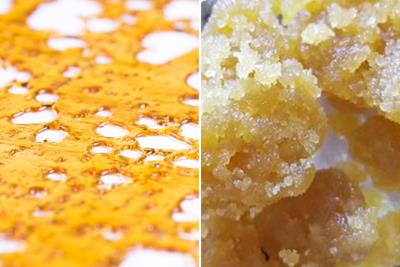
Wednesday March 3, 2021
By Erin Haitt
 420 Culture
420 Culture
As cannabis has become more accepted into the mainstream and legal across the country, technology and industry have sprung up to serve the shifting tastes of consumers, many of whom have a hankering for concentrates. The concentrate category, on the whole, is extremely diverse and can be found in a variety of products, from topicals and edible infusions to incredibly potent formulas with an enhanced THC and terpene kick.
Though the history of cannabis concentrates dates back to at least the 12th Century, today’s concentrate industry relies heavily on sophisticated lab-grade equipment for solvent-based and non-solvent-based extractions to craft concentrates like shatter and wax, among others.
How Popular are Wax and Shatter?
While it is difficult to tease out what percentage of consumers choose to dab – the process of vaporization and consumption of concentrates – there’s no doubt that the concentrate market size is already big and growing. In 2019, the concentrate market was worth approximately $1.7 billion in 2019 and is anticipated to reach $5.9 billion by 2026.

As the industry grows, consumer preference for concentrates is evolving. Where wax and shatter were once the leader of the pack, live resin and rosin are currently bypassing them in popularity. Nonetheless, wax and shatter remain staples on dispensary shelves, especially in emerging cannabis markets, and typically at a better price point than live resin and rosin. So let’s do a little compare and contrast between wax and shatter and see how they stack up.
Characteristics of Shatter
This ultra-potent concentrate ranges in color from light to dark amber and contains high terpene content and excellent flavor and aroma. In appearance it resembles thin and cracked glass; stable, but something that can be snapped with little effort. Shatter is made by blasting plant material with solvent in a closed-loop system to strip away terpenes and cannabinoids. That resulting mixture is then purged to get rid of the solvents used in extraction. After spending anywhere from 45 minutes to a full day heated at high temperature in a vacuum oven, the end product should have a glass-like appearance.

Keep in mind that shatter is not for beginners. Its THC potency can reach from 80-90 percent with a very quick onset. Should you decide shatter is for you, look for a product lighter in color, a crisp consistency, and a strong, rich aroma. Dark, discolored (or unevenly colored) shatter should be avoided, as this may be a sign of some error in the production process.
Characteristics of Wax
Like shatter, wax is made in a closed-loop system, but it is heated at a much lower temperature than shatter and is whipped vigorously until it begins to resemble whipped topping or icing. The final product is typically light to mid amber in color, has a milder aroma and flavor, and is dry and crumbly in texture. Though it can get towards a darker amber color depending on starter material, wax tends to have a slightly lighter tone because of the added air from the whipping process. Wax, however, is not as durable as shatter and it won’t last as long under the heat of a dab torch.
Differences between Wax and Shatter
There are a few trade-offs here, and the primary one is that the high from wax is not quite as intense as that delivered from shatter (but it’ll still get you hella high and right quick). Once again, wax is not for novice consumers but may offer better training wheels if you start low and go slow. The flip side of that slightly lower intensity is that wax tends to be a smoother smoke, again due to being whipped.
Think of how hard candy and cotton candy are both sugar and food coloring, but the preparation creates a different consumption experience.
Whichever concentrate you go with, either one will more than deliver on a super potent high, but there are a few more differences to take into account before making a purchase. While shatter is harder to produce, it is also more stable and lasts longer than wax. However, it is more difficult to measure, handle, and use because of its fragility. Shatter can also get quite sticky when introduced to even a little heat (like from your fingers). On the other hand, wax is easier to produce, handle, and use because of its forgiving consistency, but it is less stable than shatter and degrades a bit quicker.
Which is Better?
Is one better than the other? That depends. Shatter seems to cost a touch more than wax, but with both concentrates a little goes a very long way, and in many places the price difference is negligible. Given the subtle differences between them, it most likely boils down to preference and experience. If you’re on the fence, take a look at our concentrate guide to give you the nitty-gritty on all things concentrates so you can make a choice with confidence.
Which do you prefer between wax and shatter? Share your selections in the comments below!







